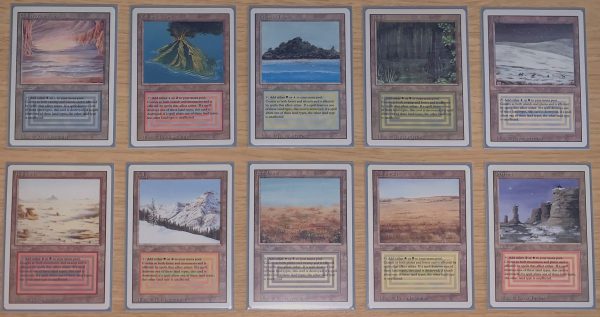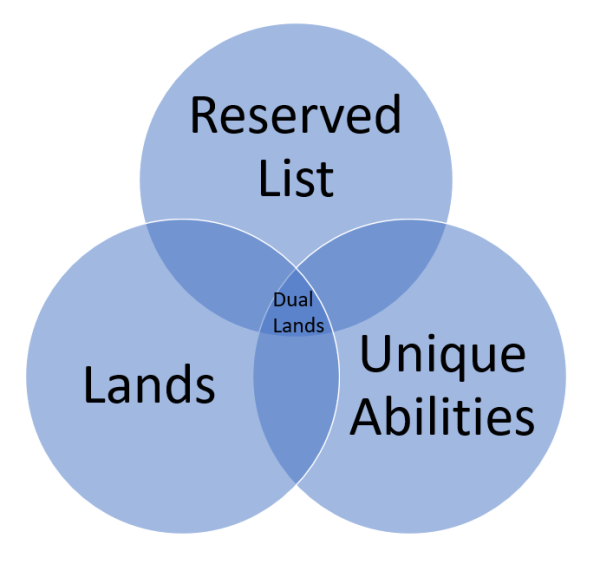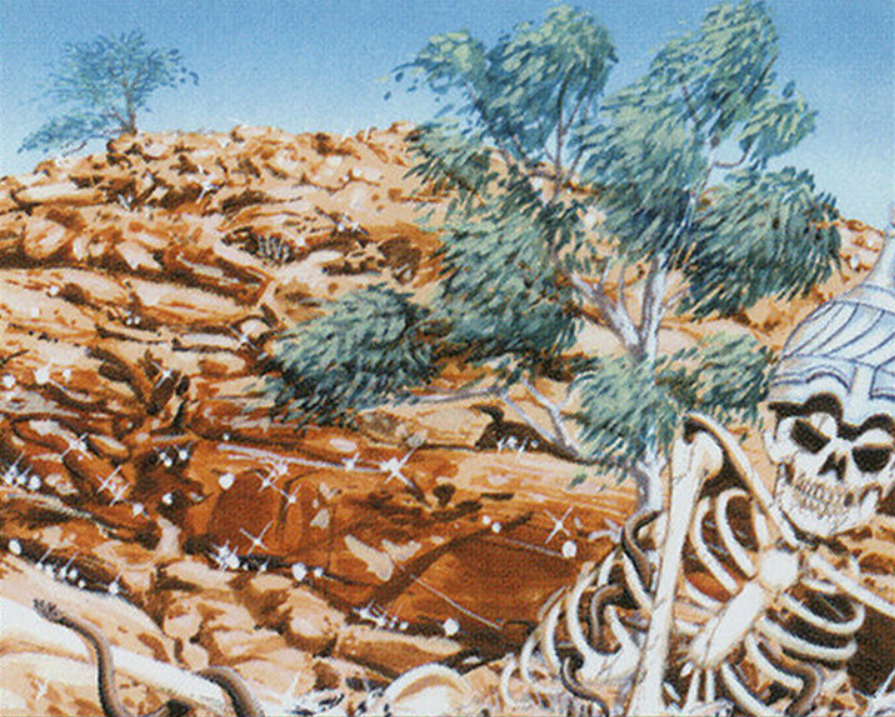Are you a Quiet Speculation member?
If not, now is a perfect time to join up! Our powerful tools, breaking-news analysis, and exclusive Discord channel will make sure you stay up to date and ahead of the curve.
Everyone is familiar with the first nonbasic lands of Magic.

The original Dual Lands check three boxes, making them some of the most desirable (and liquid) cards in the game. First and foremost, they’re on the Reserved List, much to the chagrin of many newer players. This makes them un-reprintable. Second, they’re lands, meaning they have maximum versatility and can slot into many decks. And lastly, they offer something unique. While numerous lands tap for multiple colors of mana, these are the only nonbasic lands that offer two colors of mana with virtually no drawback or restriction.
It’s no wonder these have become so expensive! In fact, on cardmarket.eu the ten Dual Lands pictured above are for sale with an €8,000 price tag.
This week I’m going to look at the overlapping characteristics that drive exorbitant prices for certain lands, sharing examples, and highlighting some cards that don’t quite make the grade.
The Trifecta
I described the Dual Lands as un-reprintable (Reserved List), lands (meaning they are highly versatile), and possessing some unique characteristic (namely, multiple colors of mana with no drawbacks or restrictions). These three traits can be captured in a simple Venn diagram.

There are surely uncountable other ways one could categorize Magic cards. But I found this simplistic approach does a fantastic job highlighting just what makes certain cards special, and therefore valuable!
The Reserved List is the first requirement. This implies the card is A) old, B) in limited supply, and C) likely to never see an increase in supply. Right off the bat, this makes a card collectible. This is why (with few exceptions) any Reserved List card has at least some value nowadays—especially any Reserved List card from Alpha, Beta, Unlimited, and even Revised.
The second characteristic I’m looking at this week is the card type: namely, I’m talking about lands. Cards with specific colors are limited in their utility simply because of the very colors they require. Some lands could theoretically slot into any deck. While mana producing lands do have some restrictions (you wouldn’t play an Underground Sea in a white/green deck), they still offer versatility and unmatched power level.
This ties into my third characteristic: having some sort of unique ability. If a land has been rendered obsolete or improved upon, its value could be capped because a newer, less expensive replacement is available. But if this hasn’t happened, and that land is the best at what it does (and what it does is really powerful), then you have a high-utility card that will drive demand.
Examples
Let’s put Dual Lands aside for a moment and examine some other examples. To do this, I’ll simply browse through the Reserved List and highlight cards that fit the three categories of the Venn diagram above.
The next set printed with Reserved List cards after Magic’s original core set is Arabian Nights. This set has multiple great examples worth highlighting. Here’s a list, along with Card Kingdom’s current buy price for near mint copies for reference.
Bazaar of Baghdad - $2240
Library of Alexandria - $1625
Diamond Valley - $650
Island of Wak-Wak - $270
Elephant Graveyard - $225
As you can see, the cards that land in the center of my Venn diagram all maintain hefty price tags. In fact, two of the three most valuable cards of Arabian Nights would fall in the center because of their unmatched power levels. No other cards in Magic are as effective at dumping cards into the graveyard to enable dredge strategies in Vintage as Bazaar of Baghdad. Remember, being a land means the card is always playable (no color requirements), un-counterable, and difficult to interact with.
Likewise, Library of Alexandria offers a versatile, un-counterable way of fueling card draw in Vintage and Old School. While many other cards let you draw extra cards, none do so in a way that’s quite this strong, hence the steep price tag!
As a card’s unique ability becomes less and less powerful, the card’s value dwindles. There’s no other powerful way to regenerate elephants like Elephant Graveyard does, for example. And the card is on the Reserved List and is a land, meaning it can fit into a multitude of decks. But who exactly is looking to regenerate elephants? It’s not a popular strategy, so the card earns a lower price. However, I’d argue that any card north of $200 is still pretty expensive!
Looking beyond Arabian Nights, we can see similar themes in the other Reserved List sets of Magic. Granted, sets with larger print runs will see lower prices on average. But relative to other cards within a given set, the same truism holds: a card that falls in the center of my Venn diagram is primed to be relatively expensive.
Other examples include Mishra's Workshop from Antiquities, The Tabernacle at Pendrell Vale from Legends, and Lake of the Dead from Alliances. It’s worth noting that Lake of the Dead only works in black decks, so it’s not as versatile as the others. But when it comes to ramping black mana in a big way, Lake of the Dead is most effective.
And of course, who could forget the Urza’s Saga group of Reserved List lands: Gaea's Cradle, Serra's Sanctum, and Tolarian Academy? These three cards are all powerful in their own right, and of course Tolarian Academy would be worth more than $500 if it wasn’t banned/restricted in every format.
The Consequence of Violating the Trinity
There are many examples of cards that lie in the middle of my Venn diagram. But what happens if one of the three criteria isn’t satisfied? Let’s take a look!
First, what happens if a card isn’t on the Reserved List, but is still a land with a powerful effect? Well, we can use a couple cards to study this. City of Brass comes to mind—granted, the Arabian Nights printing is still worth a few hundred bucks, but there are plenty of sub-$20 options thanks to all its reprints. And I would argue that if City of Brass was on the Reserved List, it’s value would rival Diamond Valley’s and probably approach four figures.
Another example worth studying is Maze of Ith. The powerful land from The Dark sees play in Legacy, offers a very powerful ability, but isn’t on the Reserved List. Because of its reprints, the card isn’t even in the top five most valuable cards from The Dark. I mean, City of Shadows is an interesting card and all, but I’ve never seen it played in a sanctioned game of Magic. Yet City of Shadows is worth three times as much, because it falls near the center of my Venn diagram.
I’m confident Maze of Ith would be the most valuable card from The Dark, north of $100, if it was on the Reserved List.
Next, let’s see what happens if a card is on the Reserved List, but isn’t all-that-powerful. My favorite example to highlight this group: Sorrow's Path, arguably one of the worst cards in Magic.
This card is still worth over $10 simply because it’s on the Reserved List, from The Dark, and maybe also because it has goofy artwork. But it’s worth less than Maze of Ith simply because the card is awful.
Alliances has a couple good examples of lands that are on the Reserved List but violate two of my criteria. Balduvian Trading Post and Heart of Yavimaya both appear on the Reserved List and they’re both lands, but they’re not really versatile lands that can be played in many decks. These two cards really only function in red and green decks, respectively. What’s more, their abilities aren’t all too impressive. As a result, they’re each worth just a couple bucks whereas something more versatile and unique, like Thawing Glaciers is around $20.
Hall of Mist is another Reserved List example. The card isn’t colored so it can be played in more lists. But the effect on the card is underwhelming: cumulative upkeep is a tough pill to swallow, and the card is only effective every other turn. Glacial Chasm is an uncommon from the same set and does a better job at stopping attackers. As a result, Glacial Chasm is worth more and sees actual tournament play, whereas Hall of Mist remains fairly useless and nearly worthless.
Wrapping It Up
Some of my favorite Magic investment ideas are cards that satisfy three key criteria: they’re on the Reserved List, offer versatile playability (like most lands), and showcase unique and/or powerful effects. Such cards are unlikely to go out of style. If something hasn’t been printed to outclass a card that initially hit the scene in the early or mid 1990’s, then chances are nothing will ever be printed to obsolete them.
As a result, cards like Library of Alexandria, Mishra's Workshop, and Gaea's Cradle will always carry lofty price tags, with significant premiums relative to lands in their respective sets that don’t tick these three boxes. You could do much worse than to drop some money on these cards, and they should offer plenty of upside over time… assuming there isn’t a major banning (I’m looking at you, Mishra's Workshop).
That’s not to say that cards that fall outside of the center of my Venn diagram aren’t going to appreciate in price, too. They just have some vulnerabilities, and their prices reflect that. City of Brass and Maze of Ith still have upside if you purchase their original printing. However, I believe their upside is limited by their numerous reprints (less restrictive for City of Brass since Arabian Nights’ print run was so small).
Likewise, Reserved List cards with less playability or versatility will still probably increase in price over time, but they offer far less exciting upside from a value standpoint—not to mention you really won’t be able to enjoy playing the cards while you wait for them to appreciate! You can leverage Diamond Valley to win games while also watching its price increase. What are you going to do with a handful of Halls of Mist? Sure, they can go from $2 to $5 in 2022, but they aren’t going to give you much utility in games of Magic while you wait.
And that’s why I love Old School cards—they offer fun play while doubling as solid non-traditional investments. Cards in this category are my favorite of all, because it’s akin to having one’s cake and eating it too. Any time you can enjoy such a benefit, it’s foolish to walk away from it. That’s a life lesson you can take to the bank!





